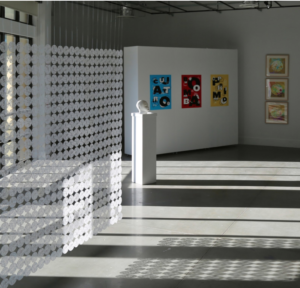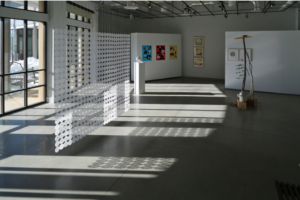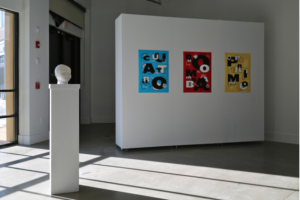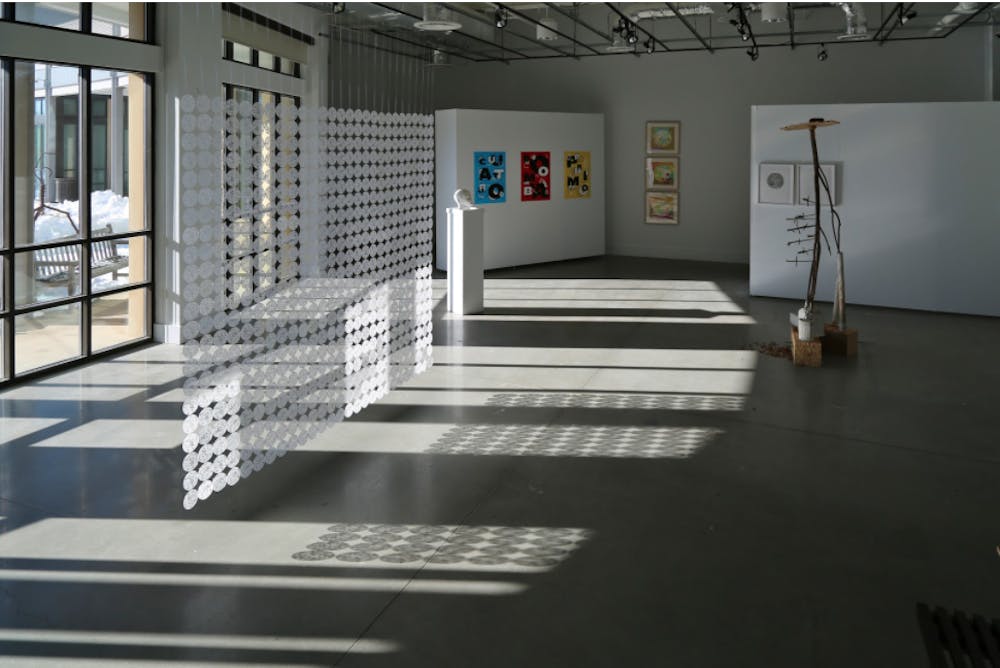By Julia Duggan
Senior Staff Writer
The College Art Gallery has officially reopened.
After almost a year of closure, the first exhibit currently available to see is called “Envision Us.” This exhibit was entirely created by professors from various fields in the Art Department. This exhibit is available to see online, as well as in person through appointments made beforehand. The exhibit is available to view from now until Mar. 14.
The inspiration for this exhibit was to show the diverse mediums that can be used for creating art. To view the exhibit online, an entire website was created so viewers could spend the time to focus on each individual piece, as well as admire the entire exhibit from afar.

“We have the physical exhibitions up in the gallery,” said Margaret Pezella-Granlund, director of the art gallery. “Many of the artists in the exhibition do sculpture or installation-based work, which means artwork composed of many components in the space, so to document the artwork well it needed to be in the gallery. Fortunately, we were able to install it in the gallery.”
When viewing the gallery online, photos are available of the artwork alongside explanations of how it is arranged in the physical space in the building.
“It is limited to the TCNJ community so faculty, staff and students,” Pezella-Granlund said. “Students can make an appointment to come and visit the gallery, and then I work out a time with them.”
Currently, Pezella-Granlund is only allowing one person in the gallery at a time. She makes sure that the gallery has time for it to be aired in between visitors.

Students will soon be able to request a catalog to be mailed to them that contains photos and detailed information about the exhibit.
“I believe we will be able to get that finished by mid March, and we will be shipping those out to people who request them,” Pezella-Granlund said. “So if you go to the exhibition website in the next week or so there will be a link there for people to be able to request a catalog.”
Jason Alejandro, assistant professor of graphic design at the College, is the first artist featured on the website. His featured artwork pays tribute to Puerto Rico.
“While most people tend to think of graphic design as capitalist decoration — logos, websites, packaging, or mobile apps — I advocate for design as a mode of inquiry: the intersection of a variety of disciplines as a means of making sense of the world around us,” Alejandro said on the exhibit website.
Alejandro’s artwork features bright colors and bold words that come from the Spanish language. According to the website, these words have multiple meanings and these words were picked specifically to reflect how languages have multiple layers. Depending on the context, the meaning of the word can change.

Anita Allyn, professor and coordinator of fine art & photography/video, is the next artist featured in the exhibit. Her art is focused on the environment. Using fake plants, a neon sign and vinyl murals, this piece is in response to another piece of art she completed in 2019. The piece completed in 2019 was placed in the Wissahickon Valley Park, Philadelphia.
The next featured artist is Dr. Belinda Haikes, associate professor and coordinator of graphic design. Her art is centered around the metaphors of Americana and technology. This artwork features her graphite art of the moon. Accompanied with the moon is a phrase stating that the moon is always there even when someone does not see it.
Kyle Lopinto, the safety and studio technician, created a sculpture that is featured in this exhibit. The sculpture is accompanied with a drawing.
“I resist the urge to say that what I do is just an ethic of recycling, though that is certainly a part of it,” Lopinto said on the exhibit website. “The idea of waste is unsettling to me and working with what might otherwise go abandoned and unused brings me a certain amount of comfort. But it is more than that. Inherent in making do with only what I can find forces me to develop the ability to solve problems in an ad hoc way.”
Elizabeth Mackie, professor of fine art & photography/video, also created a piece that is focused on the environment. She draws her inspiration from extended media, including video, audio and textiles. The website states the artwork was created in 2020 with the assistance of two student collaborators Lily Gilston and Sarah Valente.
“For the past 14 years, my work has focused on global warming and its effects on bodies of water,” Mackie said on the website.
The next featured artist is Liselot Van Der Heijden, professor of fine art & photography/video. Her artwork is a photograph of people in a city interacting with one another. Marchelo Vera-Lee, professor of fine art & photography/video is another artist featured in this exhibit. His artwork uses a variety of mediums including printmaking, and various fabrics.
“Expanded print media represents a metaphor of my personal history, a passion for cultural exchange, and lifestyle,” Vera-Lee said on the website. “My work often juxtaposes distressed urban decay and architectural structures that are ubiquitous in any developing global city. These collaged images of networks and systems are brought together through a variety of hybrid post-digital and traditional printmaking methods.”
The last artist that has a piece featured in this exhibit is Eddie Villanueva, Foundations Coordinator and Assistant Professor of Fine Art. His artwork is a 3D printed sculpture that explores conflicting feelings of gender and sexuality.

“I am interested in the ways by which male identity manifests itself both publicly and privately,” Villanueva said on the website. “How gender, and in my case male gender, is performed and how a chasm between the personal experience and the cultural creation and sanctioning of gender identity can lead to a sense of double consciousness or personal rift within one’s sense of self.”
With viewing the art exhibit in person or online, there is an emphasis on the individual experiencing the art rather than a group.
“It is a very different viewing experience,” Pezella-Granlund said. “It is not like a whole pack of people going in and hanging out in the gallery at once, but it is sort of a one-on-one view experience of you and the art.”







